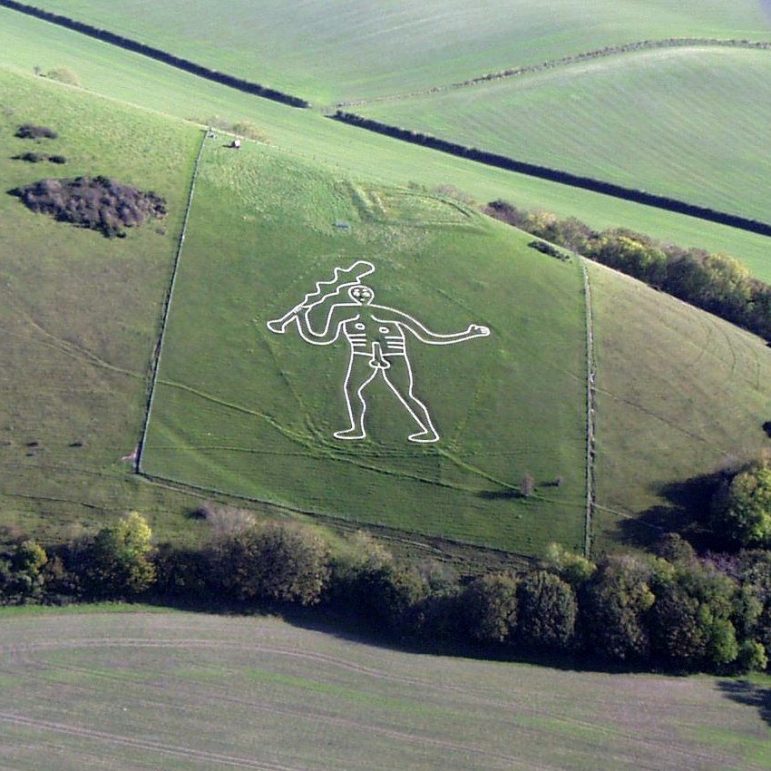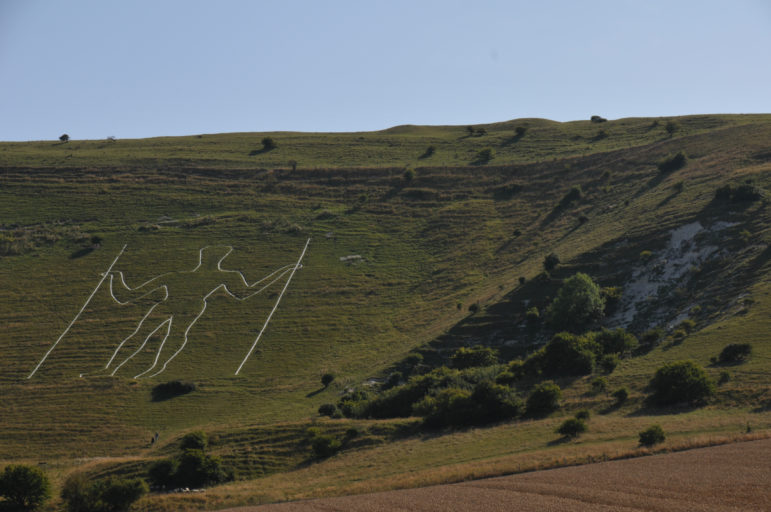CERNE ABBAS, Dorchester, England – The United Kingdom is host to a number of chalk figures, many of which are old and of uncertain origins.
The Long Man of Wilmington and the Uffington chalk horse are among these and said to be thousands of years old, but the origins of the third of the country’s most mysterious chalk figures, the Cerne Abbas giant (a naked figure which is, let’s say, undeniably masculine) have always been vague.

Aerial view of the Cerne Abbas giant – Image credit: PeteHarlow – CC BY-SA 3.0
The figure does not appear in local records before 1694, although since the figure appears distinctly fertility-oriented and records are often compiled by members of the church, this is perhaps not surprising. The figure does not appear in a 1617 survey by John Norden, a man described by archaeologists as “famously thorough.”
More recent theories have suggested that he dates from the 17th century and is a crude mockery of Oliver Cromwell, whose enemies referred to him as ‘England’s Hercules’ (the figure has often been compared to the Greek hero). Some have also suggested that the giant is prehistoric, but this hypothesis was ruled out in July last year when analysis of snails from the site revealed his origins to be more recent. Yet the question of when the giant had been placed there, though narrowed, remained open.
However, new methods of testing soil samples have revealed that the giant dates from around the late 10th century, which makes him an Anglo Saxon construct. Originally, he wore a belt, and the configuration of this suggests that his erect penis may be a later addition to the figure, as we shall note below.
Independent geoarchaeologist at Allen Environmental Archaeology in Codford, Mike Allen, conducted the survey in 2020, taking samples from the giant’s feet and elbows.
Optically stimulated luminescence (OSL) dating, which shows when any material was last exposed to light, was used on sand samples and the results show that the giant cannot be earlier than 700 CE, even if the chalk of which he is made has been re-dug several times.
The lack of records may be a result of the chalk giant having become overgrown by long grass, although some historians have pointed out that ancient monuments unrelated to the church or the political structure of the country tend not to get much of a mention in earlier records anyway – including Stonehenge.
Archaeologists warn that the “big three” chalk figures cannot be lumped together in terms of age or significance: the chalk horse at Uffington is generally agreed to be prehistoric, for example.

Aerial view of the Uffington chalk horse – Image credit: Dave Price, CC BY-SA 2.0
A Benedictine monastery was built at Cerne Abbas in the 10th century. Local Dorset legends claim that it was established in an attempt to convert people away from the worship of a god named Heil or Heilith, of whom we know very little.
Some archaeologists have suggested that the giant might be a local protest against the building of the abbey.
Alison Sheridan, a freelance archaeological consultant, comments, “It would almost seem to be an act of resistance by local people to create this fantastically rude [Pagan] image on the hillside. It’s like a big two fingers to the abbey.”
Other researchers disagree. TWH spoke to historian Kari Maund, who said:
I seriously doubt there’s a Pagan context: it’s more likely to be a statement of resistance to political or social change (e.g. the rather harsh Benedictine reforms, which were driven by a royal cabal around Aethelred’s mother; or possibly someone commenting on the succession to Eadgar…it could be someone underwhelmed by religious reforms during the early years of Aethelred.
The abbey is unlikely to have had anything to do with the construction of the figure directly, but you never know.
Alice Raw from Corpus Christ College, Oxford, points out in the Guardian letters column that it is a modern response in finding it hard to imagine clerics sponsoring the image of a naked man with an enormous erection: some of the clerical writings of the time, for example the Book of Exeter, are distinctly bawdy.
She adds:
… we should welcome the restoration of the giant to his early English habitat, rethinking our assumptions about medieval religious culture as we do so.
However, Professor Richard North (UCL) suggests that etymology may be our friend in proposing a Pagan origin for the giant. He comments, also in a recent letter to the Guardian, that ‘heilith’ resembles the Old English word hæleð, i.e. haeleth, meaning “man” or “hero” and could refer to the Norse deity Freyr, known for his gigantic size, his role in fertility, and his habit of taking a stag’s horn or club into battle with him.

The Long Man of Wilmington, a hill figure near Wilmington, Sussex. Image credit: August Schwerdfeger – CC BY 4.0
Is this the definitive word on the Cerne Abbas figure? Perhaps not. We consulted Professor Ronald Hutton at the University of Bristol, who told The Wild Hunt that:
The dating from the OSL process, which puts the giant in the period 700-1300 (only half of which is Anglo-Saxon) if you take all the results together, actually raises as many problems as it solves.
For one thing, it is in the least likely period, culturally, for the figure to have been carved. It makes sense in both an ancient and early modern context, but not an early or high medieval one when there is no recorded tradition of carving hill figures and no place for a virile Hercules (the number of knots on the club is specifically that of a classical Hercules, so it must be he).
For another it clashes with the snail shell evidence, which suggests a later date, so something is wrong with one set of data or the other.
For a third, the LiDAR survey which accompanied the OSL exercise found that the figure had been remade at some point, as the phallus crossed the line of a belt, so it may originally have lacked the genitals and looked very different. As a result, things are now even less clear than before.
The mystery of the Cerne Abbas giant continues!
The Wild Hunt is not responsible for links to external content.
To join a conversation on this post:
Visit our The Wild Hunt subreddit! Point your favorite browser to https://www.reddit.com/r/The_Wild_Hunt_News/, then click “JOIN”. Make sure to click the bell, too, to be notified of new articles posted to our subreddit.